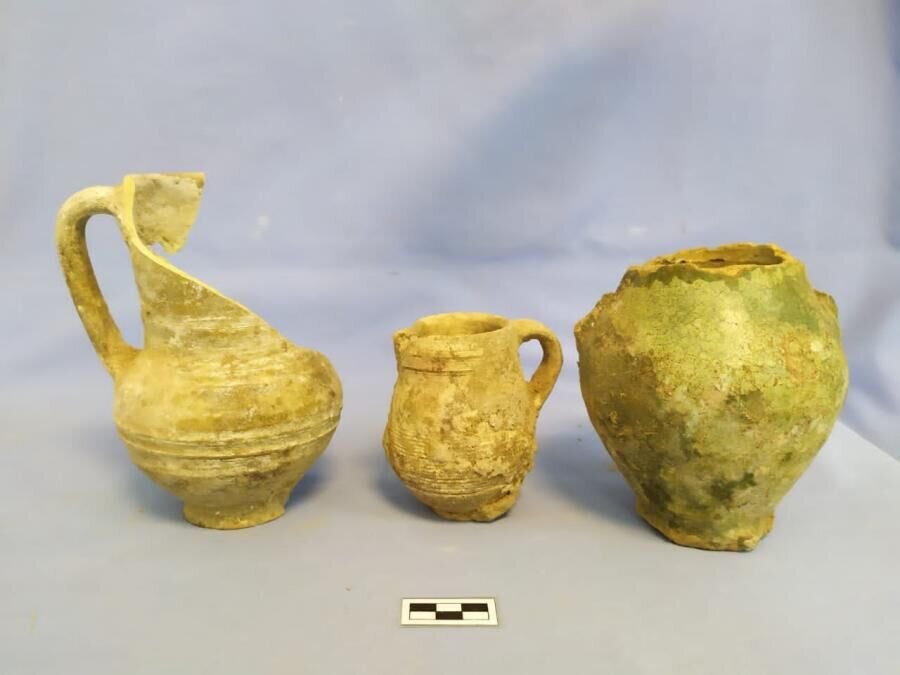Ancient potteries probably exposed by flash flood discovered in Susa

TEHRAN – Local guards in charge of protecting cultural heritage have discovered three ancient potteries which had probably been exposed to sunlight due to a flash flood in Susa, southwest Iran.
“Following recent downpours, guards of the Cultural Heritage Preservation Unit discovered three potteries during their [routine] through inspection across the historical site of Beitol-Mashhout in Susa,” IRNA quoted a local police commander in charge of cultural heritage protection.
“The objects, which were obtained with the keenness and vigilance of the protection unit personnel, are three pottery objects that, according to the initial estimates, date from the (early) Islamic era,” Ramin Maknavi said.
Early in January, a series of torrential rain triggered flooding in southern provinces of the country.
The UNESCO-designated Susa, now situated near the modern city of Shush, is one of Iran’s most treasured sights. Susa is identified as Shushan in the Book of Esther and other Biblical books.
It was once the winter residence of Persian kings after having been captured by Cyrus the Great. Susa became part of the Persian Empire under Cyrus II, the Great in 538 or 539 BC.
It is said that Alexander of Macedonia captured Susa in 330 BC and plundered the city, seizing some 40,000 talents of gold and silver from the treasury. Alexander the Great initiated Shushan’s decline by favoring Babylon and shortly after, following a revolt, the city was burnt to the ground. Subsequently rebuilt by Sapor II (309-379 CE), it was renamed Iranshahr Shapur and later helped in the resistance against the Arab invasion of 645.
After the fall of the Achaemenid Empire and the reign of Alexander the Great, who married in Susa, the city became part of the Seleucid empire. It was now called Seleucia on the Eulaeus. A palace in Greek style was erected, next to Darius’ palace. The administrative center, however, was in the southern part of the city, where nearly all Greek and Parthian inscriptions were discovered. In the Parthian age, the city minted coins.
During the Sasanian age, the city had a large Christian community. It was sacked by the Sasanian king Shapur II, who transferred the population to Iwan-e Karkheh, but Susa was sufficiently recovered in the early seventh century to fight against the Arabs, who nevertheless captured the city which remained important until the thirteenth century CE.
In the Bible, Susa is known primarily from the story of Esther in which Haman the Agagite planned to defeat the Jews of Persia. According to the story, Esther outwitted him by persuading her husband, King Ahasuerus of Persia, to sabotage Haman’s plan. The episode is commemorated every year in the Jewish Purim festival which is marked with costumed parties and other celebrations, according to Ancient Origins.
Furthermore, Susa is also mentioned in Nehemiah and Daniel, both of whom lived in the city during the 6th century BC in the period known as the Babylonian captivity when several Jews were held captive following the siege of Jerusalem by Nebuchadnezzar. A tomb known as Shush-Daniel is believed to be that of Daniel himself. It is capped by an unusual white cone which some believe was formerly a stone ‘Star of David’.
A wide variety of artifacts discovered in Susa includes carved cylinder seals, jewelry, clay balls, and clay tablets with cuneiform inscriptions recording business transactions, political history, and mathematical calculations.
Susa has yielded ample relics including pottery, arms, ornamental objects, metalwork, bronze articles, as well as clay tablets. The ancient site is also a gateway to several worthy destinations such as the UNESCO-tagged ziggurat of Tchogha Zanbil, the ruins of Achaemenid Apadana Castle, Shush Castle (Akropol), Prophet Danial Shrine, Museum of Susa, the archaeological mount of Haft Tapeh.
All and all, archaeological evidence suggests that Susa has been continuously inhabited since 4,200 BC placing it among the oldest continuously inhabited cities in the world. In addition, there are traces at Susa of a village inhabited around 7,000 BC and painted pottery dating from ca. 5,000 BC at the site.
AFM
Leave a Comment